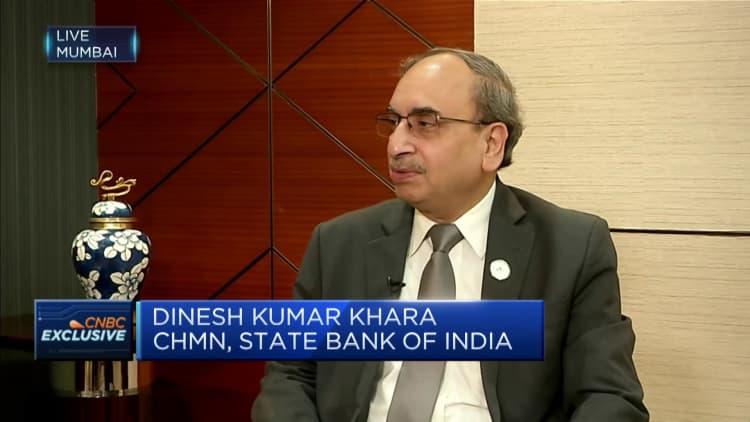Economists and analysts say India has become the destination of choice for many investors – in part because it is doing better than many of its peers in a time of economic volatility.
But research also shows that India still has a long way to go towards building infrastructure and enacting reforms that could attract foreign investors, many of whom still find it difficult to do business in the country.
“The Indian economy has held up better than most other economies around the world,” Aswath Damodaran, professor of finance at New York University’s Stern School of Business, told CNBC.street signs asia” last week.
“It’s been held up in terms of growth, in terms of strength, and it also attracts money because where else can the money go, right? I mean, you’ve taken out a lot of markets, the money has to go somewhere.”
“The reality is that India benefits from having an exotic economy and being a place where capital goes, and that too can change over time. But for now, I can understand why India is an attractive market for many foreign institutional investors.”
Indian Prime Minister Narendra Modi plans to make India a $5 trillion economy by 2024-25.
Bloomberg | Bloomberg | Getty Images
Shrinking GDP forecast
India’s GDP growth forecast for 2022 has continued to fall, dropping to around 6% in light of global headwinds such as higher interest rates, raising the prospect of a recession.
The United Nations Conference on Trade and Development said India’s GDP growth will slow to 5.7% in 2022, after it hit 8.2% for 2021. In 2023, it expects a lower growth rate of 4.7%.. The World Bank also lowered its 2022-23 GDP growth forecast for India to 6.5%, from an earlier estimate of 7.5%.
While the credit rating has been downgraded, India’s growth outlook continues to fall above other growth forecasts in the Asia Pacific region. The ASEAN+3 macroeconomic research bureau reported, last week, that ASEAN+3 (which includes China, Japan and South Korea), for example, is expected to grow 3.7% this year, while economists have lowered their growth forecast for China to between 2 %. and 4%.
Insufficient infrastructure
In recent months, Indian Prime Minister Narendra Modi and Indian business leaders, such as billionaire Gautam Adani, have redoubled their efforts to market India to global investors.
Modi has plans to make India a $5 trillion economy by 2024-25While Adani said at the recent Forbes conference in Singapore that India will go from a $3 trillion economy to a $30 trillion economy in the next 25 years.
But in research conducted to test Modi’s $5 trillion target last year, Deloitte India He said that although the country is a preferred destination for foreign direct investment, it has to undertake more reforms to achieve this goal.
The report highlighted the need for more foreign direct investment in the manufacturing sector, adding that the bulk of the investment was driven by the services sector, where manufacturing attracts only about a third of the money going into services.
A worker prepares vermicelli, which is used in a traditional sweet dish popularly eaten during the holy month of Ramadan, at a factory in Allahabad on April 13, 2021.
Sanjay Kanujia | Afp | Getty Images
Moreover, the majority of the 1,200 business leaders surveyed by Deloitte said that India presents a greater challenge to doing business than countries such as China and Vietnam.
Business leaders in India’s real estate, industrial and utilities sectors are finding it particularly difficult to invest there thanks to low institutional stability and inadequate infrastructure.
“While perceptions of China have taken a beating over the past year, the country remains a close competitor to India among US investors as a destination for their capital investment,” the report said.
Sasidran Gopalan, assistant professor of economics at UAE University, said India’s reforms have improved over the years and are moving in the right direction.

However, while Gopalan agreed that India “is standing out in its own backyard and among other emerging markets”, he said it is not “the only game in town”.
Lee Kwan Yoo sRamkishn Rajan, a professor of public policy in Singapore, acknowledged that India’s developing reforms and infrastructure push had caught the attention of investors, but said its trade protections were still a drawback.
“So India is seeing a mixture of good politics and good luck at the moment. So overall, I understand the upside in India, although there is a caveat,” Rajan said.
“While there has been a relaxation of FDI regulations, India’s reluctance to embrace further trade liberalization including accession to regional trade agreements may hamper the extent to which labor-intensive manufacturing is entering the country.”
This would prevent the country from making full use of the “demographic dividend,” Rajan said.

. “Proud zombie lover. Evil pop culture buff. Amateur thinker. Total food practitioner. Tv evangelist.”
